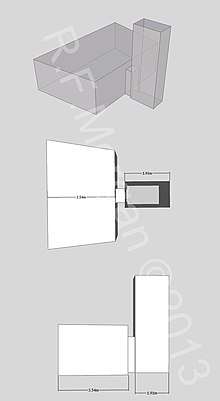KV44
KV44 is one of 65 numbered tombs in the Valley of the Kings. It was discovered and excavated by Howard Carter in 1901 and was re-examined in the 1990s by Donald P. Ryan . It consists of a single chamber accessed by a shaft. When discovered, the tomb was blocked and inside were discovered three mummies in wooden coffins; these belonged to Tentkerer, a lady of the house of Osorkon I, Heiufaa, and an unnamed songstress of Amun. These burials, belonging to the Twenty-second Dynasty, are evidently secondary burials since they were placed on rubbish filling about one fifth of the tomb. In this rubble the remains of seven earlier mummies were found, without coffins or funerary equipment. Several bee nests on the ceiling indicate that the tomb had lain open for some time in antiquity. The original cutting of the tomb is dated to the Eighteenth Dynasty.[1]
| KV44 | |||
|---|---|---|---|
| Burial site of unknown | |||
 KV44 | |||
| Coordinates | 25°44′24.5″N 32°36′10.8″E | ||
| Location | East Valley of the Kings | ||
| Discovered | 26 January 1901 | ||
| Excavated by | Howard Carter Donald P. Ryan | ||
Owner of the tomb
Nothing is known of the original occupants of KV44 but it has been suggested that this was a tomb for Anen.

This theory was proposed by Elizabeth Thomas based on topography and the fact that Anen was not buried in TT120. Excavations dating to 1990–1991 by Ryan showed however that none of the 18th Dynasty materials in the tomb date to later than the middle of the 18th Dynasty. Hence at this point there is no archaeological evidence for the burial of Anen in TT44.[2]
References
- Carter, Howard: Report on Tomb-Pit Opened on the 26th January 1901, in the Valley of the Kings Between no. 4 and no. 8. In: ASAE 2 (1901), p. 144-145
- Lyla Pinch Brock, Jewels in the Gebel: A Preliminary Report on the Tomb of Anen, Journal of the American Research Center in Egypt, Vol. 36 (1999), pp. 72-3